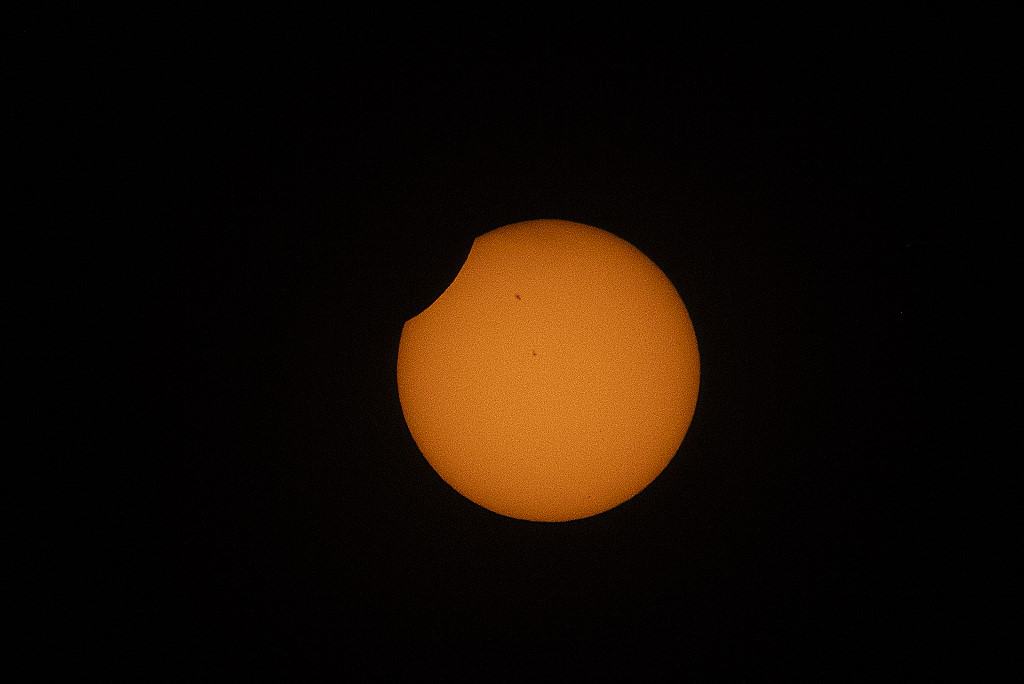Millions of viewers in America with telescopes, cameras with filters and special glasses observed this Saturday the “ring of fire” formed by an annular eclipse of the Sun on its path through the continent, from north to South America.
In the Planetarium of Bogota, an astronomical center in the capital of Colombia, a thousand people vibrated around noon when the clouds allowed to see the eclipse.
Bad weather threatened to prevent it, but the “ring of fire”, the effect created by the fact that the Moon does not completely cover the Sun, was visible for a few seconds and caused smiles and tears of happiness.
Xiomara Cifuentes was moved to tears. Along with her husband and her three young and teenage children, she was looking through a telescope made of cardboard.
At first, when the sky was covered it was “distressing,” she said. Then it was “very exciting.” “It will be a pleasant memory” for the family in the future, added the 41-year-old public official.
Protected with special glasses Jhoan Vinazco, a 25-year-old university student, saw a solar eclipse for the first time. It was “a very nice moment (…) an indescribable thing, without words,” he said.
The eclipse began to become visible in the United States in the state of Oregon shortly after 09:00 local time (16:00 GMT), on the Pacific coast. It continued its path southward and in the city of Albuquerque it motivated applause.
It was then seen in Mexico, Honduras, Costa Rica, Panama and other parts of Central America, as well as in Colombia and Brazil before ending at sunset in the Atlantic Ocean.
In a scenario similar to that of Bogota, in Manaus, capital of the state of Amazonas, in northwest Brazil, the eclipse could be observed despite the gray sky due to the toxic cloud that has enveloped the city for days due to fires in the rainforest Amazon.
NASA, which broadcast live between 3:30 p.m. and 5:15 p.m. GMT, had urged people to take preventive measures and use solar viewing glasses, never regular sunglasses, to preserve their vision.
Eclipse with sounds
Prior to its passage through South America, the phenomenon brought crowds together at universities, astronomical observatories, archaeological sites in Honduras and Mexico, such as the majestic Teotihuacan pyramids, at the Masaya Volcano in Nicaragua or on the beaches of the Caribbean in Costa Rica.
In the hot Yucatan Peninsula (east), where the phenomenon was most visible in Mexico, hundreds gathered at the Great Mayan World Museum. “Witnessing an eclipse here is an unforgettable and energizing experience,” said Pierre Durand, 42-year-old French anthropologist.
In Central America it was seen in some cities in all countries, sometimes with difficulty due to the clouds.
In Penonomé, 160 km from Panama City, Carlos Ramírez received the eclipse dressed as a space traveler. “Since I was a child I dreamed of being an astronaut (…) I found the event here in Panama spectacular,” Colombian-born tour guide Carlos Ramírez, 55, told AFP.
For the blind there was also an opportunity. Santos Espinal, 54, was among a dozen blind people who enjoyed the eclipse at the Astronomical Observatory of the National University of Honduras, through the “Light to Sound” technological system.
“As the eclipse changes, the sound changes,” he told AFP, excited.
Rockets
The event also serves as an appetizer for a total eclipse that will occur in April 2024. Both eclipses will be “absolutely impressive for science,” said Madhulika Guhathakurta, helio physics program scientist.
Solar eclipses have a noticeable effect on the upper atmosphere, as well as the ionosphere, which is full of charged particles and responsible for reflecting and refracting radial waves.
“Although the atmospheric effects of solar eclipses have been studied for over 50 years, many questions remain unanswered,” Guhathakurta said.
To study these effects, NASA will launch three rockets from the White Sands Missile Range in New Mexico, to collect information on the electric and magnetic fields, electron density, and temperature.
A total eclipse occurred in 2017 in the United States. After the total eclipse next April, the next will occur in 2044, while the next annular eclipse will be in 2046.
“A unique phenomenon, when I see it again I will be over 40 years old!” said Martha Salmerón, 23, a tourist from Mexico City.
Another total eclipse will also be visible in Spain in August 2026. The Sun is about 400 times larger than the Moon, but it is also 400 times further away. Therefore, both celestial bodies appear to be a similar size when viewed from Earth.






